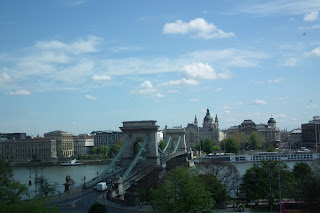We pulled into Budapest first thing this morning, just before daylight. Big City on both sides of the Danube. We parked on the Pest side. Budapest started out as two separate cities during the middle ages, Buda on the west side of the Danube, and Pest on the east. Today thay are one city joined by at least six or seven bridges, the most famous of which are the Chain Bridge and the Elisabeth Bridge.

Note the monument to St. Gellert on the hill at the end.

Note the monument to St. Gellert on the hill at the end.
We rode a funicular railway up to the Buda Castle high on the northwest hill.
 We walked around for most of the day until our feet hurt and we were really hungry. Ate dinner in a cool place called Apostolok (potentially "The Apolstles' Cellar") with booths and mosaics of the Apostles on the walls.
We walked around for most of the day until our feet hurt and we were really hungry. Ate dinner in a cool place called Apostolok (potentially "The Apolstles' Cellar") with booths and mosaics of the Apostles on the walls.












































